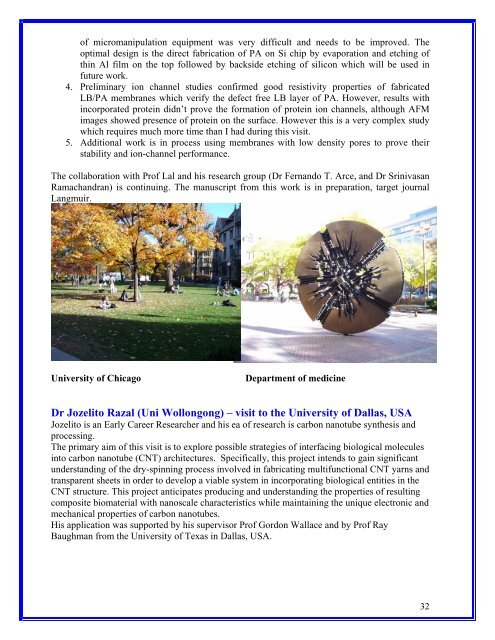Annual Report 2007 - The Australian Nanotechnology Network
Annual Report 2007 - The Australian Nanotechnology Network
Annual Report 2007 - The Australian Nanotechnology Network
Create successful ePaper yourself
Turn your PDF publications into a flip-book with our unique Google optimized e-Paper software.
of micromanipulation equipment was very difficult and needs to be improved. <strong>The</strong><br />
optimal design is the direct fabrication of PA on Si chip by evaporation and etching of<br />
thin Al film on the top followed by backside etching of silicon which will be used in<br />
future work.<br />
4. Preliminary ion channel studies confirmed good resistivity properties of fabricated<br />
LB/PA membranes which verify the defect free LB layer of PA. However, results with<br />
incorporated protein didn’t prove the formation of protein ion channels, although AFM<br />
images showed presence of protein on the surface. However this is a very complex study<br />
which requires much more time than I had during this visit.<br />
5. Additional work is in process using membranes with low density pores to prove their<br />
stability and ion-channel performance.<br />
<strong>The</strong> collaboration with Prof Lal and his research group (Dr Fernando T. Arce, and Dr Srinivasan<br />
Ramachandran) is continuing. <strong>The</strong> manuscript from this work is in preparation, target journal<br />
Langmuir.<br />
University of Chicago Department of medicine<br />
Dr Jozelito Razal (Uni Wollongong) – visit to the University of Dallas, USA<br />
Jozelito is an Early Career Researcher and his ea of research is carbon nanotube synthesis and<br />
processing.<br />
<strong>The</strong> primary aim of this visit is to explore possible strategies of interfacing biological molecules<br />
into carbon nanotube (CNT) architectures. Specifically, this project intends to gain significant<br />
understanding of the dry-spinning process involved in fabricating multifunctional CNT yarns and<br />
transparent sheets in order to develop a viable system in incorporating biological entities in the<br />
CNT structure. This project anticipates producing and understanding the properties of resulting<br />
composite biomaterial with nanoscale characteristics while maintaining the unique electronic and<br />
mechanical properties of carbon nanotubes.<br />
His application was supported by his supervisor Prof Gordon Wallace and by Prof Ray<br />
Baughman from the University of Texas in Dallas, USA.<br />
32



